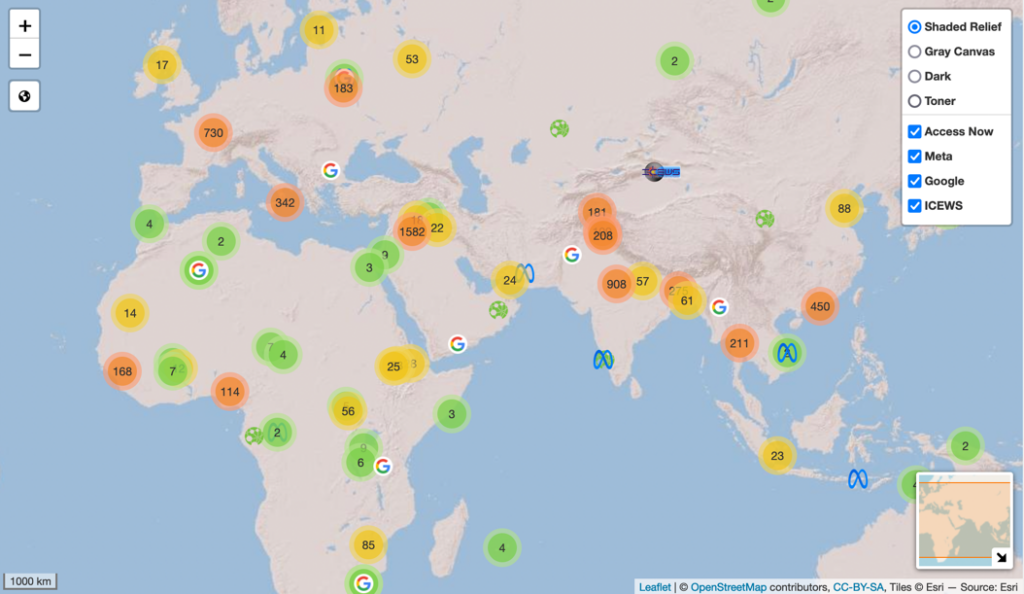Introduction
As authoritarian governments increasingly use internet shutdowns to censor content, it has become critical to understand the language surrounding internet shutdowns and how it fits into the broader field of information controls. Despite their use as a tool for digital repression, there is uncertainty surrounding what an “internet shutdown” is and the types of shutdowns that exist. Existing taxonomies of shutdowns often focus on the technical methods of implementation, leaving a gap for a taxonomy focused on non-technical measurements, such as duration and geographic scope. In response to the growing threat of internet shutdowns and the need for definitions and taxonomies, new research focused on the phenomenon of internet shutdowns proposes two novel technical frameworks: 1) a framework for types of internet shutdowns, and; 2) a non-technical framework for grouping existing taxonomies surrounding internet shutdowns. These frameworks were primarily concerned with the terminologies and the taxonomies of internet shutdowns and aimed to simplify the language and classification of this phenomenon.
An interactive internet shutdown dashboard was also created, which brought together several sources on internet shutdowns to highlight the value of data triangulation but also included contextual data, such as data on protests. Lastly, a bibliometric analysis of internet shutdown literature was conducted and demonstrated the value of exploring shutdowns through computational methods.
The Global Information and Technology Controls Hub (GLITCH) Research Interest Group at the University of Oxford supported this research and promoted the sustainability of the work conducted as part of the OTF fellowship. The group’s website hosts the outputs described below.
Terminologies and Taxonomies of Internet Shutdowns
The first use of the term “internet shutdown” is often traced back to the Arab Spring of the early 2010s, when several governments ordered ISPs to disable their services in an attempt to curb protests and other forms of collective action At the time, the term “internet shutdown” offered a broad explanation to this unique method of digital repression used by authoritarian governments, but provided little in the way of explaining this form of censorship. While several organizations have proposed their own definition, there is uncertainty about what defines an “internet shutdown”.
Comparing and contrasting these definitions is the first step to clarifying the term “internet shutdown”. In addition to these definitions, numerous synonyms or related terms exist, including blackout, kill switch, throttling, digital siege, and digital curfew. These terms, sometimes used interchangeably by academics, journalists, or civil society organizations, may contribute to the confusion about what is and is not an internet shutdown. Furthermore, the sheer number of terms that refer to a shutdown may explain why some studies often group all types of shutdowns as an “internet shutdown” rather than making a distinction between a “network shutdown” and “platform blockage”. As such, there is merit in proposing a simplified framework. At a minimum, providing an overview of the various definitions of an “internet shutdown” and related terms may be helpful.

This chart, demonstrating the “Four Pillars of Internet Shutdowns”, is a four-part framework to understand the primary types of internet shutdowns. The four pillars mainly refer to the following definitions:
- Internet Blackout
The termination of all internet services across all networks and platforms - Network Shutdown
The cessation of all internet services on a specific network, such as a mobile or fixed-line broadband (i.e. a ‘partial shutdown’) - Platform Blockage
The blocking of a specific platform used for two-way communications, such as social media. - Internet Slowdown
A type of shutdown where typical internet speeds (bandwidth/throughput) fall below a certain threshold, rendering internet use impractical. This could also be considered “internet throttling”.
Regarding taxonomies, several authors or organizations have proposed classifying different types of internet shutdowns or outages. These taxonomies are concerned with the technical reasons for how an internet shutdown occurred, such as through DNS or IP blocking. While there is value in comparing existing taxonomies, we believe that proposing a non-technical taxonomy would be the most significant value-add for non-technical researchers aiming to analyze shutdowns in a methodologically principled manner. Currently, many studies group all forms of internet shutdowns into the same bucket. Therefore, there is value in differentiating between, for example, a small geographic and short-duration shutdown (Type 1A) from a large geographic and long-duration shutdown (Type 2B). Creating a matrix of shutdowns in this format ensures that similar types can be grouped and analyzed within and between types.
To learn more, please view the associated paper.
Interactive Data Dashboard for Internet Shutdowns
The fellowship also created an interactive data dashboard that enables users to explore data on information controls in a novel way. The USP of the dashboard is the world map, as it has a high level of geographic granularity and brings together data on internet shutdowns and political-related event data such as the occurrence of protests.

In addition to the interactive data dashboard and associated blog post, a separate post produced a brief overview of internet shutdown resources to further support those looking to better navigate the internet freedom community, including data sources or organizations, circumvention tools, and funding sources.
A Bibliometric Analysis of Internet Shutdowns
This fellowship also consisted of a bibliometric analysis of shutdown literature, which served two primary goals. First, to inspire others to apply computational methods to explore shutdowns from unique perspectives. Second, to provide a basic mapping of shutdowns literature to assist those looking to understand the scholastic landscape better.
There has been an increase in documents focused on internet shutdowns which are roughly correlated with the rise in recorded shutdowns.

Descriptive, co-citation, co-word, thematic, and collaboration analyses were conducted to better understand these documents. These analyses provided several valuable insights. For example, the most cited shutdown-related authors or manuscripts, the thematic development of shutdown literature over time, or which seminal works internet shutdown publications are co-citing.
Further Reading
I invite you to explore The Global Information and Technology Controls Hub (GLITCH) Research Interest Group at the University of Oxford, which hosts the outputs described in this post.

